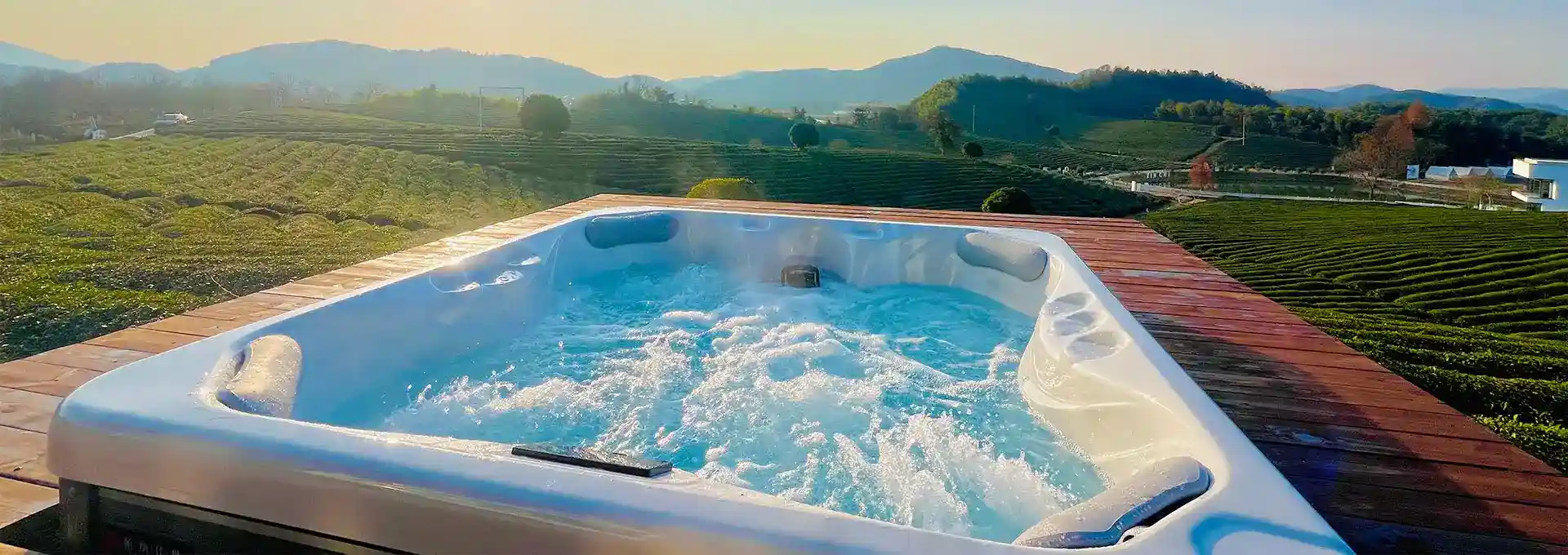Can You Actually Swim in a Swim Spa?
2024-08-26 13:36:52
The concept of a swim spa seems almost too good to be true: a compact, luxurious space where you can swim in place against a controlled current, offering the benefits of a swimming pool with the convenience of a hot tub. But can you actually swim in an outdoor swimming spa, or is it just an aquatic fantasy? This comprehensive guide will explore the capabilities and limitations of swim spas, answering the question on everyone's mind and providing in-depth insights into what you can expect from this innovative aquatic fitness solution.
How Do Swim Spas Compare to Traditional Pools for Swimming?
Swim spas have been designed with the express purpose of providing a swimming experience in a smaller footprint than traditional pools. Let's delve deeper into the comparisons:
Size and Space:
While traditional pools offer a large area for swimming laps, swim spas are more compact, with a dedicated swimming area that can still accommodate a swimmer's needs. Typical swim spa dimensions range from 12 to 21 feet in length and 7 to 8 feet in width, compared to the average residential pool size of 32 feet by 16 feet. This significant size difference makes swim spas an attractive option for homeowners with limited outdoor space or those looking to maximize their backyard's functionality.
Current Control:
One of the standout features of swim spas is the adjustable current, which allows swimmers of all levels to tailor their workout intensity. Most swim spas use powerful jets or propulsion systems to create a smooth, consistent flow of water that simulates open water swimming. Users can adjust the current's strength to match their skill level and desired workout intensity, making it suitable for beginners and experienced swimmers alike.
Water Motion:
Swim spas use pumps and jets to create a continuous flow of water, simulating the action of open water swimming. This system typically consists of multiple jets positioned at different depths, creating a wide, deep current that provides a more natural swimming experience. Some high-end models even incorporate advanced propulsion systems that minimize turbulence, resulting in a smoother swim.
Versatility:
Beyond swimming, outdoor swimming spas often include additional features like hydrotherapy jets and seating areas for relaxation, making them multifunctional. This versatility allows users to transition seamlessly from an intense swim workout to a relaxing hydrotherapy session, all within the same compact unit. Many models also include built-in exercise equipment, such as rowing bars or resistance bands, further expanding their fitness capabilities.
Energy Efficiency:
Swim spas generally require less water and energy to operate compared to traditional pools. The smaller water volume means less chemical treatment is needed, and heating costs are typically lower. Additionally, many swim spas come with insulated covers that help maintain water temperature when not in use, further reducing energy consumption.
Year-Round Use:
Unlike outdoor pools that may be unusable during colder months, swim spas can be used year-round. Many models are designed for both indoor and outdoor installation, with proper insulation and heating systems that allow for comfortable use even in cooler climates.
Maintenance:
Swim spas generally require less maintenance than traditional pools due to their smaller size and self-contained nature. The water circulation system helps keep the water clean, and many models come with built-in filtration systems that simplify maintenance routines.
What Factors Influence Swimming Efficiency in Swim Spas?
Efficiency in a swim spa is influenced by several factors that can significantly impact the quality of the swimming experience:
Swim Spa Size:
Larger outdoor swimming spas provide more room for swimming, allowing for longer strokes and less turning. The length of the swim spa is particularly crucial, as it determines how much space a swimmer has to complete their stroke before encountering the end wall. Wider swim spas can also accommodate different swimming styles more comfortably, such as butterfly stroke, which requires more lateral space.
Current Settings:
The strength and direction of the current can be adjusted to match the swimmer's pace, affecting the intensity and efficiency of the workout. Advanced swim spa models offer multiple current settings, allowing users to fine-tune the flow to their exact preferences. Some high-end units even feature programmable current patterns that can simulate open water conditions or provide interval training options.
Water Temperature:
Warm water can be more comfortable for swimming but may also affect buoyancy and resistance compared to cooler water. Most swim spas allow users to adjust the water temperature, typically ranging from 80°F to 104°F (27°C to 40°C). For intense swimming workouts, a temperature between 78°F and 84°F (26°C to 29°C) is often recommended to prevent overheating while maintaining comfort.
Swimmer's Skill Level:
Skilled swimmers may find it easier to maintain an efficient swimming technique in an outdoor swimming spa compared to beginners. However, the controlled environment of a swim spa can be beneficial for swimmers of all levels to improve their technique and endurance. Beginners can start with a gentler current and gradually increase the intensity as they build confidence and skill.
Water Depth:
The depth of the swim spa can affect swimming efficiency, especially for taller swimmers or those practicing certain strokes. Most swim spas have a uniform depth throughout, typically ranging from 4 to 5 feet, which may require some adjustment for swimmers accustomed to deeper pools.
Current Uniformity:
The quality and uniformity of the water current play a significant role in swimming efficiency. High-quality swim spas create a wide, deep current that remains consistent from top to bottom, providing a more natural swimming experience. Less advanced models may have more turbulent or narrow currents, which can make maintaining proper form more challenging.
Propulsion System Design:
The type and design of the propulsion system used in the swim spa can greatly influence the swimming experience. Some models use multiple jets to create the current, while others employ paddle wheel systems or propellers. Each design has its own characteristics in terms of current smoothness, width, and adjustability.
Can Swim Spas Support Different Swimming Techniques and Workouts?
Swim spas are versatile and can accommodate various swimming techniques and workouts, making them suitable for a wide range of aquatic activities:
Lap Swimming:
Many outdoor swimming spas are designed to allow for continuous swimming, with the current compensating for the swimmer's forward motion. This setup enables swimmers to practice and perfect their stroke technique without the need for turns. The adjustable current also allows for progressive training, where swimmers can gradually increase the intensity as their endurance improves.
Resistance Training:
The water's resistance can be used for strength training and to improve swimming stroke technique. Swimmers can perform drills focusing on specific aspects of their stroke, such as catch and pull exercises, using the current as a form of resistance. Some swim spas come with attachments like tethers or stationary swimming harnesses, which can be used for more focused technique work or to assist less confident swimmers.
Recovery Workouts:
The controlled environment of a swim spa is ideal for low-impact recovery workouts, especially for athletes. The buoyancy of water reduces stress on joints and muscles, making it an excellent option for active recovery or rehabilitation exercises. The warm water option in swim spas can also help relax muscles and improve circulation, aiding in the recovery process.
Aquatic Aerobics:
Besides traditional swimming, swim spas can be used for aquatic aerobics and other water-based exercises. Many swim spa models come with built-in exercise equipment such as underwater treadmills, rowing attachments, or resistance bands. These features allow users to engage in a variety of low-impact, high-intensity workouts that combine cardiovascular exercise with strength training.
Cross-Training:
Swim spas provide an excellent environment for cross-training, allowing athletes from various sports to incorporate water-based workouts into their routines. The resistance of the water combined with the adjustable current can help improve overall fitness, endurance, and muscle strength without the high impact associated with land-based exercises.
Technique Refinement:
The consistent current in a outdoor swimming spa allows swimmers to focus on refining their technique without the distractions of turns or lane changes. Some models even feature underwater cameras and video analysis systems, enabling swimmers to review and improve their form in real-time.
Triathlon Training:
For triathletes, swim spas offer a convenient way to train for the swimming portion of their events. The ability to simulate open water conditions through adjustable currents can help prepare athletes for race day scenarios. Additionally, some swim spa models allow for the attachment of stationary bikes, enabling triathletes to transition quickly between swimming and cycling workouts.
Family Fitness:
Swim spas can accommodate multiple users, making them ideal for family fitness activities. While one person swims against the current, others can engage in water aerobics or resistance exercises in different areas of the spa. This versatility makes swim spas an excellent investment for families looking to incorporate more physical activity into their daily routines.
Conclusion
Swim spas are indeed capable of providing a realistic and effective swimming experience, despite their smaller size compared to traditional pools. They offer adjustable currents, a versatile environment for various types of workouts, and the convenience of hydrotherapy benefits. The compact nature of outdoor swimming spas makes them an attractive option for homeowners with limited space, while their energy efficiency and year-round usability add to their appeal.
Whether you're a casual swimmer looking for a low-impact workout, an athlete in need of a year-round training solution, or a family seeking a versatile aquatic fitness center, a swim spa could be the perfect addition to your home. As technology continues to advance, we can expect to see even more innovative features in swim spas, further enhancing their ability to provide a comprehensive aquatic workout experience.
Before investing in a swim spa, it's essential to consider factors such as available space, intended use, and budget. It's also advisable to test different models to find one that best suits your swimming style and fitness goals. With the right outdoor swimming spa, you can enjoy the benefits of swimming and aquatic exercise in the comfort and convenience of your own home, regardless of the season or weather conditions.
If you want to get more information about this product, you can contact us at info@iparnassus.com!
References:
1. "Swim Spa vs. Pool: Which is Best for You?" Pool and Spa Market
2. "The Efficiency of Swimming in Swim Spas." Aquatic Fitness Today
3. "Maximizing Your Swim Spa Workout." Swim Spa Fitness Guide
4. "How Swim Spas Are Changing Home Exercise Routines." Home Fitness Review
5. "The Benefits of Lap Swimming in a Swim Spa." Active Living Journal
6. "Swim Spa Currents: How They Work and How to Use Them." Modern Swim Spa
7. "Designing Your Dream Swim Spa." Backyard Design Magazine
8. "The Impact of Water Temperature on Swimming Performance." Aquatics International
9. "Swim Spas for Athletes: Training Tips." Sports Training Edge
10. "A Guide to Aquatic Aerobics in Swim Spas." Fitness in Water



